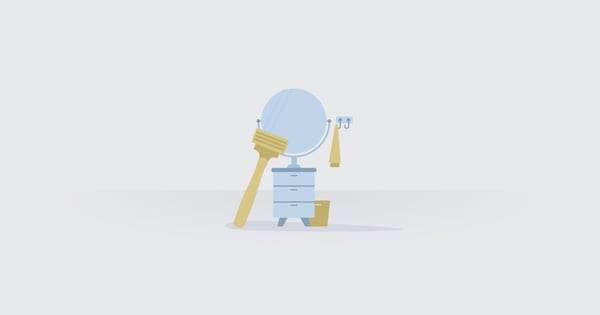Ever heard of Harry’s? Since founding the company in 2013, co-founders Jeff Raider and Andy Katz-Mayfield have turned their shaving subscription service into a global online powerhouse.
And the numbers don’t lie:
- $250 million in venture capital (Inc.)
- $200 million in revenue in 2017 alone (Adweek)
- 3 million monthly recurring customers and counting (LinkedIn)
But what’s most interesting, and what I want to focus your attention on, is their marketing strategy. Not because it’s anything new. But rather because it’s applicable to any e-commerce store, regardless of size.
I recently spent a month reverse-engineering Harry’s marketing strategy, and today, I want to show you five battle-tested strategies you can use to get more engagement and higher conversions.
The best part? They work even if you don’t have venture capital or a multi-million dollar marketing budget.
Sound good?
Let’s get started.
Harry’s Marketing: 5 Must-Know Strategies You Need to Steal
I recommend reading this article from beginning to end (preferably with a nice warm cup of coffee).
But if you’re pressed for time and eager to dive in, click a link below to jump to a strategy of interest (Strategy #5, particularly Email #3, is genius):
1. Create Brand Advocates with 3 Emotionally-Driven Story Archetypes
2. Win New Business with This Replicable Word-of-Mouth Referral Engine
3. Build White Hot, White Hat Backlinks with These 3 E-Commerce Link Building Tactics
4. Convert On-The-Fence Buyers with These 3 Proven Ad Angles
5. Engage Subscribers and Increase Average Order Value (AOV) with “The CPS Method”
1. Create Brand Advocates with 2 Emotionally-Driven Story Archetypes
Harry’s leverages two classic storytelling archetypes in its marketing:
- The welcomed prophet
- The scrappy underdog
Let’s look at each in detail.
Story Archetype #1: The Welcomed Prophet
Beginning with their about page (appropriately named “Our Story”), Harry’s position themselves as a remedy to a problem that’s plagued men for decades: overly-expensive razor blades.
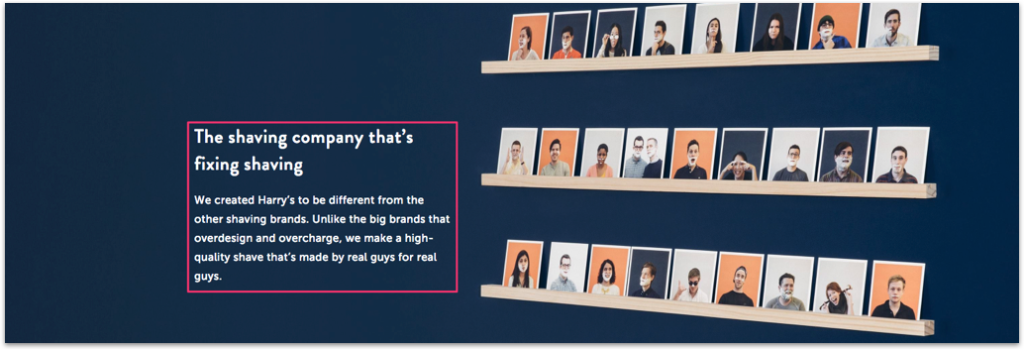
Further, they define what they do, who they do it for, and, further down, why they do what they do. Your Why, the reason you do what you do, is essential. As Simon Sinek says, “People don’t buy what you do; they buy why you do it.”
Without their Why, Harry’s is another “me-too” online retailer looking to make a fast buck from a lucrative industry. But with it, they’re a voice for the everyman, a cause worth getting behind (more on that in a moment).
What’s interesting is, if you look hard enough, you realize Harry’s brand themselves as what copywriter Dan Kennedy calls “a welcomed prophet.”
Put it this way: people know razor blades are expensive. They always have. And they always will. Yet few companies rose to the occasion and explicitly referenced it in their marketing.
Harry’s knows good marketing is a result of saying things to buyers that reinforce and confirm what they already believe.
Unsurprisingly, it’s an archetype that resonates with their audience on an emotional level. Such that, that Harry’s has been able to get 324 backlinks to their about page alone:

Action Item. Ask yourself, “What do people believe—specifically—that I can show up and agree with, so you can sell to them?” Then, put your answer in your marketing.
For example, if you sell women’s clothes, you can address the overwhelm and inconvenience that comes from clothes shopping (TrunkClub does a superb job of this on their about page).
Story Archetype #2: The Scrappy Underdog
When Harry’s launched in 2013, they entered a heavily-dominated industry, with Gillette owning 66.3% of the market share:
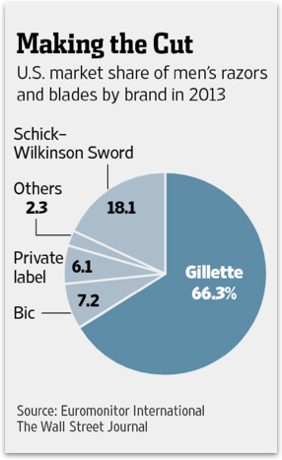
In the beginning, Harry’s was up against what many considered an insurmountable challenge. But Harry’s accepted and assumed the role of David to Gillette’s Goliath—and they ran with it.
You can see it in their “infomercial” below, referencing Gillette as a “Big Razor Company”:
Harry’s role as “the scrappy underdog” isn’t anything new; companies have played that role for as long as the archetype has had a name. But what’s interesting about Harry’s approach is threefold.
First, it’s consistent throughout their marketing. You see this from their ads to their alternative pages:

Second, it’s reaffirmed by fans in YouTube or Facebook comments:
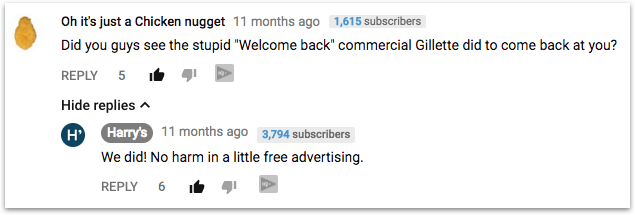
Third, it’s reinforced elsewhere when they’re covered by media outlets like Forbes and Marketing Week (after all, it’s a great angle for a story):
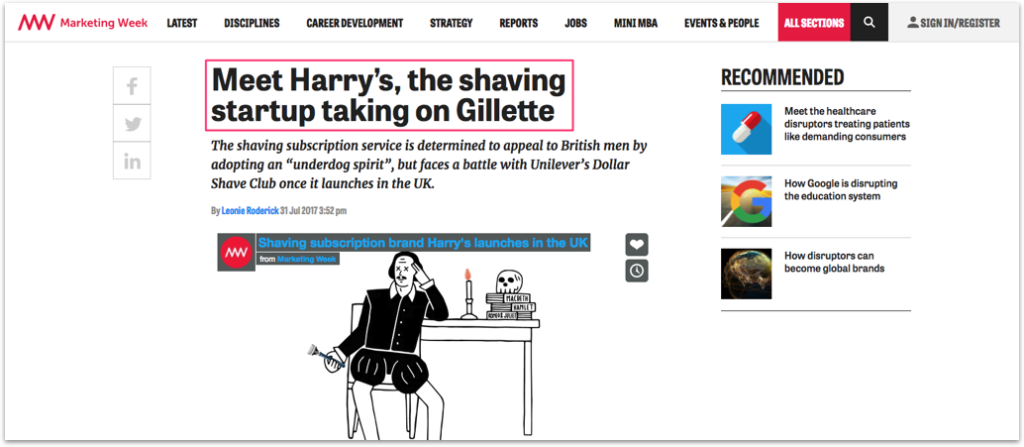
We love stories of heroism. But we especially love rooting for the underdog. They’re an ordinary person—just like you—and they’re worth investing in.
Inviting customers to invest in you emotionally, when appropriate, gives you an advantage over your competitors. If, say, your “Big Razor Company” tries to undercut you on price (like Gillette tried recently with their “cheaper” blades), your customers will stay with you. Why? Because if they’re a part of something greater than themselves, they’re invested in you before the brand.
Like many products, razor blades are a commodity that you can buy at a cheap price. But, once a customer has invested in your brand, they remain loyal (providing you continue nurturing that relationship) and are willing to pay a premium price.
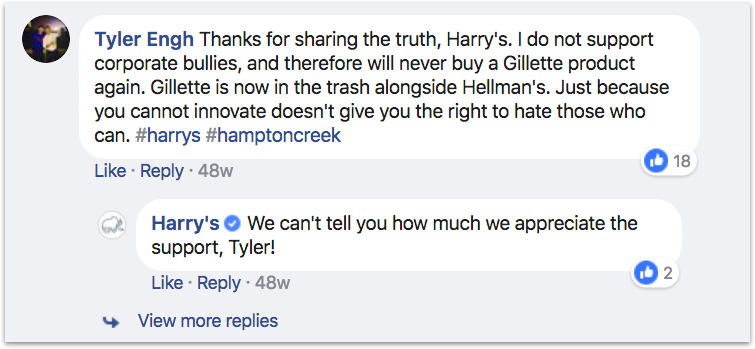
Action Item: Brand advocates are essential in today’s economy, so give customers a reason to invest in you emotionally using story archetypes. You don’t have to use the ones listed above; there are countless story archetypes to choose from.
But what’s most important is to have your story consistent throughout your marketing. You want to remind people why you’re worth investing in and being a part of.
2. Win New Business with This Replicable Word-of-Mouth Referral Engine
If you’re like most business owners, you know the importance of referral marketing. But few build a predictable and repeatable referral system into their marketing.
And the numbers couldn’t be more revealing.
According to ReferralCandy, 83% of satisfied customers are willing to refer products and services. So far, so good. Yet, only 29% actually do.
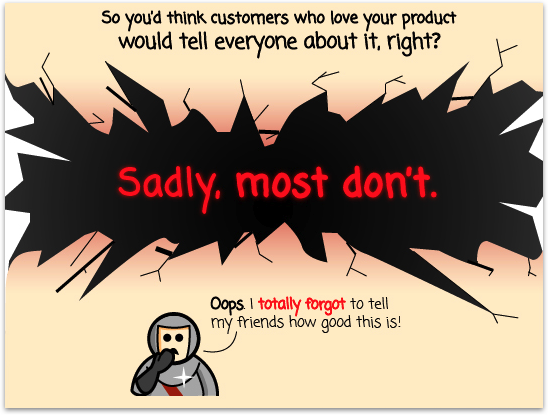
Harry’s knows this better than anyone. From day one, they built a fully-automated word-of-mouth referral engine—before they even had a single customer.
And the results were remarkable.
One week before their e-commerce site went live, Harry’s acquired 100,000 email addresses through a week-long pre-launch campaign.
“The idea for our campaign was built around our belief that the most powerful and effective way to be introduced to our new company was through a credible referral,” writes Co-Founder and CEO Jeff Raider. “Thus, we focused on building a campaign that helped people to spread the word to their friends.”
Below is how their campaign works. Model it. You might not get 100,000 email addresses, but you will skyrocket your list-building efforts.
Step 1: Use Email Outreach to Notify Your Friends and Family
Harry’s had just 12 employees in the beginning. Twelve. That’s it. Now imagine going from 12 email addresses to 100,000 in one week. Impressive, isn’t it?
Each employee wrote a personal email to everyone in their network notifying them of the launch and inviting them to opt in on a landing page (more on that below).
Step 2: Drive Traffic to a Dedicated Landing Page
On the homepage, Harry’s invited users to leave their email addresses to get notified of the site’s launch:
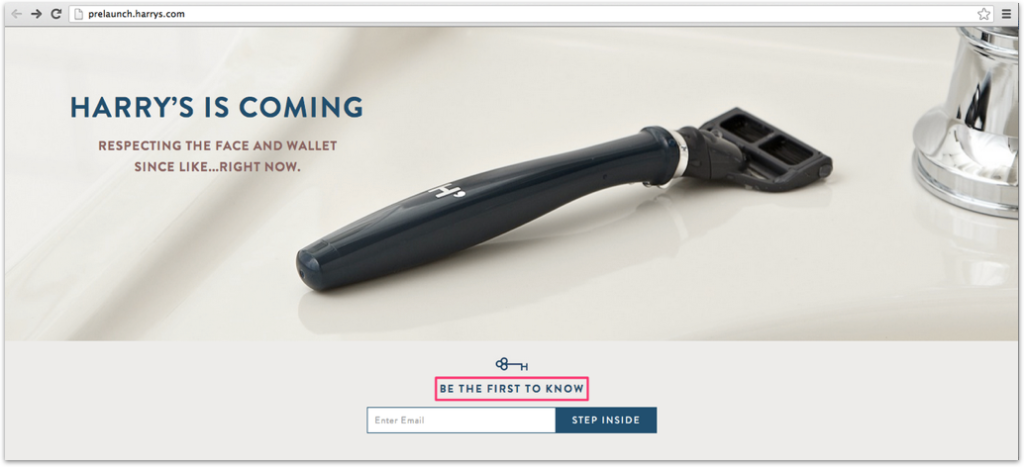
(Harry’s cryptic headline urged users to opt in to learn more.)
A clear design with a curiosity-driven headline. Nothing new there. But here’s where it gets interesting…
Step 3: Invite Users to Share on Social (with a Twist)
After opting in, Harry’s invited users to refer others on social in exchange for freebies:
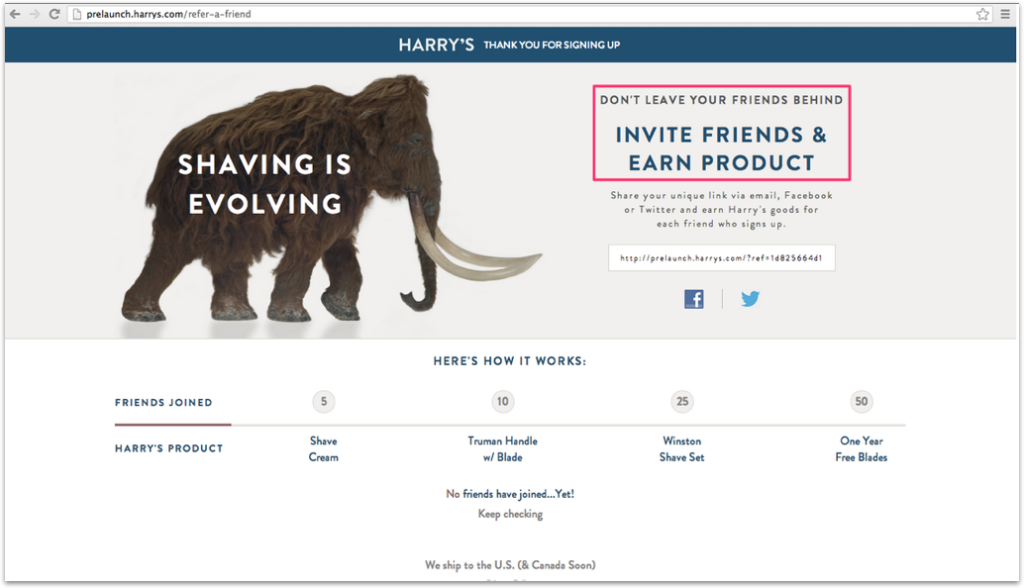
And that’s not all…
The more friends the user referred, the better the prizes they won. For instance, if they signed up five friends, they won a free shave cream. Not bad for a few minutes of work. But if they referred 50 friends, they won the grand prize: a year of free shaving.
“We wanted the entire experience to feel like a fun game.” writes Raider. “We heard from some friends that they took the referral campaign like a personal challenge.”
And that they did:
A whopping 77% of the emails came from referrals, meaning around 20,000 people referred around 65,000 friends.
We only want to refer others to offers that are interesting and make us look good. So, while it’s unlikely all 65,000 subscribers were relevant, it’s safe to assume a fair percentage were, giving Harry’s a highly-targeted list of prospects before even opening for business.
Step 4: Use Software to Safeguard Yourself Against Fraud
Not everyone, of course, is honest. Few will take advantage of the opportunity. Using SendGrid, Harry’s sent an email to every email address entered. If that email bounced, SendGrid interpreted the email address as illegitimate and removed it from the contest.
Four years after Harry’s launch, referrals continue to be a big part of their traffic share, with 220,000 sessions in the past three months alone (as of writing):

Action Item: It’s tempting to believe a large audience necessitates virality. But, as we’ve seen, even a few referrals can compound exponentially.
If you’re launching a new product/service or looking to reach new audiences, use software like KickOffLabs to create a viral campaign. Offer freebies in exchange for referrals and, above all, make it super simple for users to share.
3. Build White Hot, White Hat Backlinks with These 3 E-Commerce Link Building Tactics
Before moving forward with this section, we need to address the elephant in the room.
Harry’s has acquired a TON of backlinks from the press. Their meteoric rise has featured in countless high-authority sites, including The New York Times, The Guardian, and Forbes:
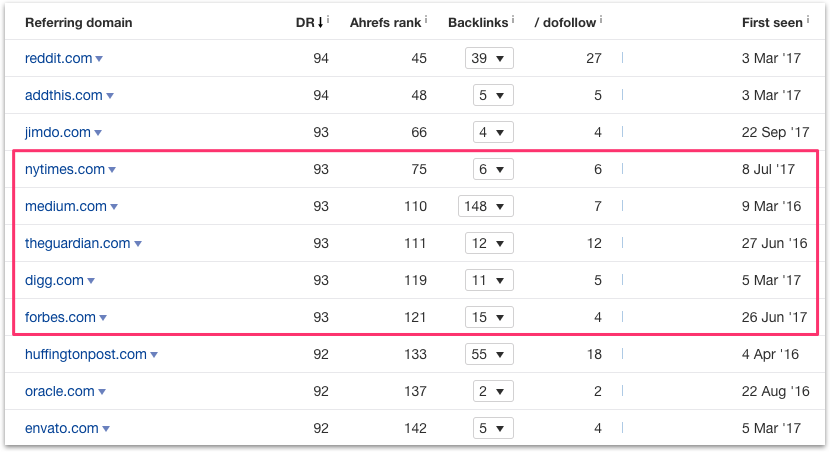
Writing you can achieve similar results would insult your intelligence. I am NOT going to do that. But what I am going to do is show you three untapped link-building strategies Harry’s used that you can, too.
These include:
- The Best-Of Backlink Builder
- The Poster Boy Formula
- The Marketer Magnet
Let’s discuss each step-by-step.
Link Building Strategy #1: The Best-Of Backlink Builder
A common search query for customers at the consideration stage of the buyer’s journey is “best [blank] for [blank].” Harry’s is a subscription box service mainly for men. Here’s what I found when I searched for “best subscription box services for men”:
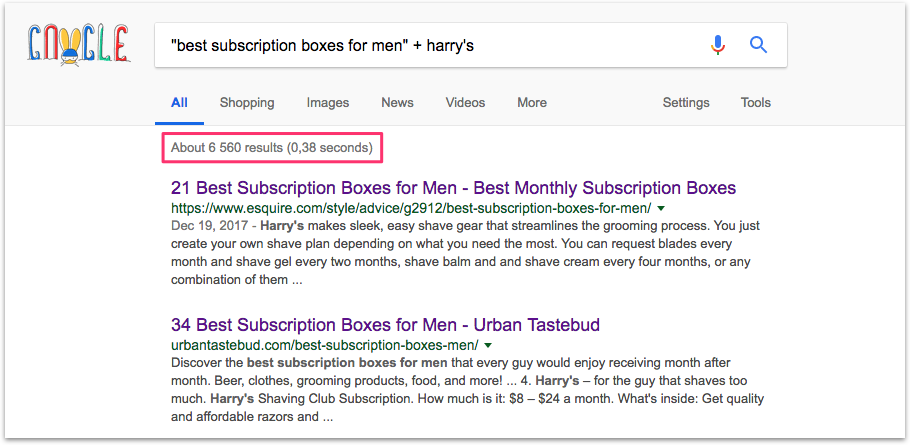
Google delivered 6,560 search results for that exact phrase. Impressive.
PureWow is one example of a site that featured Harry’s in a best-of article called “The 50 Best Subscription Boxes”:
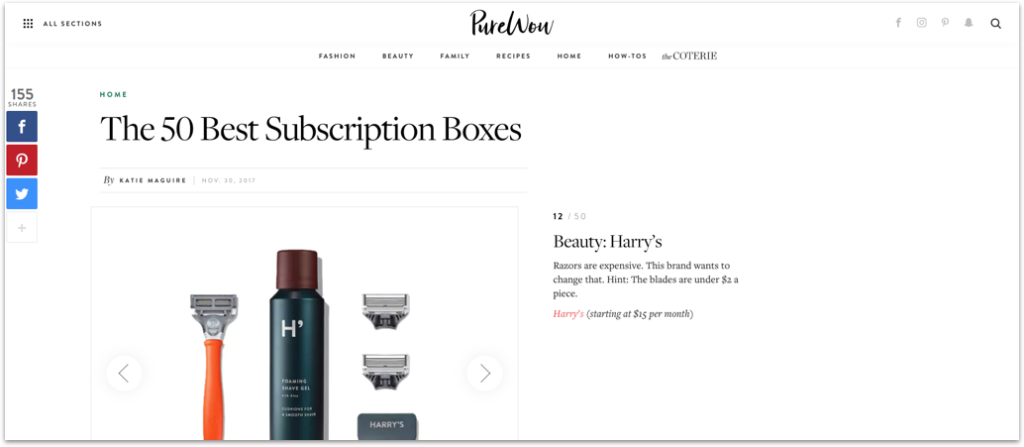
This one article earned them a nice link from a site with a domain rating score of 77:

Whether Harry’s marketing department reached out for this link is irrelevant: You don’t need to wait for sites to link to you; you need to reach out and ask.
Here’s how to do that.
First, run a search for “best [blank] for [blank].” For example, if you sell women’s yoga pants, you might search for “best yoga pants for women” (I recommend adding “+ [current year]” for up-to-date content):
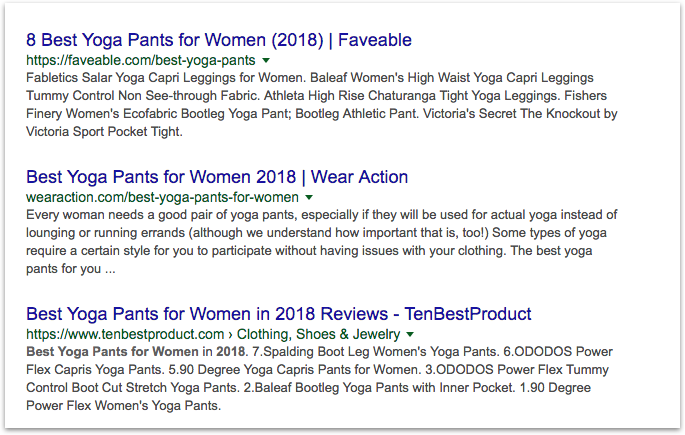
If you want to go one step further, you can add + [competitor] to the search operator:

You can even go to ‘Tools > Past Week” to get recent results (this makes link building easier):

Check each site’s DR and add any sites with an identical DR to your site (or higher) to a spreadsheet. Then, reach out to them, asking them if they would consider adding your site to their list. Yes, it’s time-consuming. But it works.
Link Building Strategy #2: The “Posterboy Formula”
Coined by Bryan Harris, the “Posterboy Formula” involves writing a customer testimonial in exchange for a link to your site.
Here’s how it works:
- Choose a company with an audience like yours
- Buy one of their products
- Notify the company specifying the results you achieved
- Offer to write a case study
No one is exempt from using the “Posterboy Formula”. In fact, Harry’s got a juicy 92DR link from ZenDesk after writing a case study on how they deliver effortless customer service:
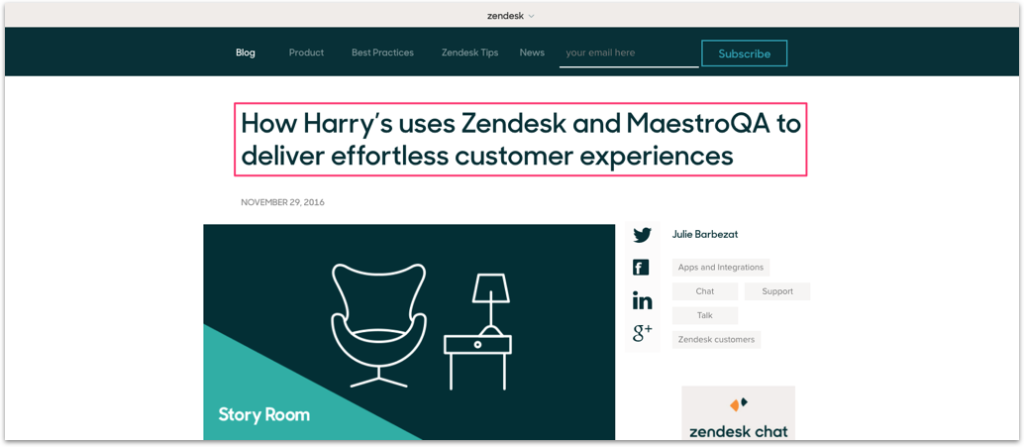
Link Building Strategy #3: The Marketer Magnet Method
No matter what industry you’re in, marketing blogs always want unique marketing examples for their content.
Take our article on abandonment cart emails, for instance.
We wanted to go above and beyond with that post, so we abandoned dozens of checkouts to get great email examples.
When we included a site’s email in our article, we linked to them. But we also got links to our content from other blogs because our examples weren’t available elsewhere.
Here’s a link we got from Neil Patel’s blog:
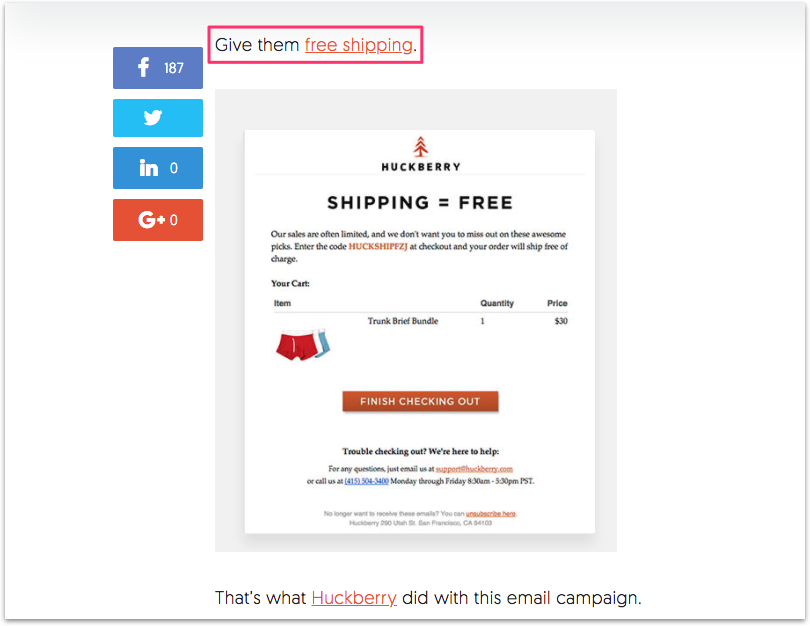
Win. Win.
Harry’s knows this better than anyone. They have countless examples of good marketing to link to and feature. (I wouldn’t be writing this article otherwise, right?).
From their about page to their Facebook ads to their email marketing, Harry’s gives marketing blogs never-ending fodder for their content.
Here’s an example of Kissmetrics praising Harry’s customer support portal:
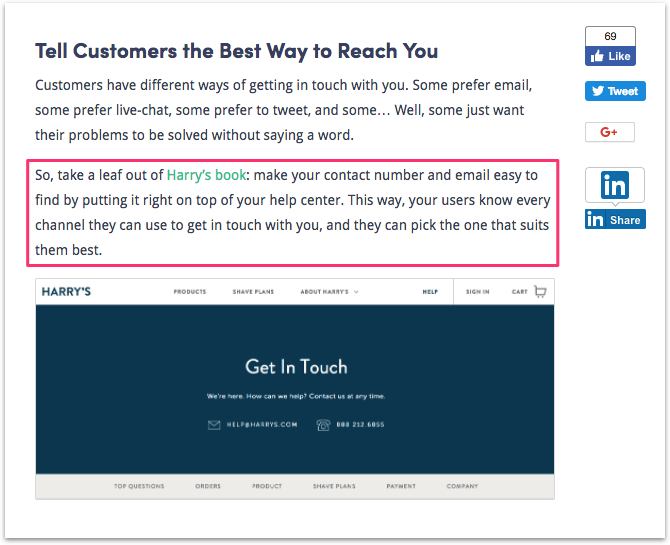
Action Item. To create content that’s a marketer magnet, go above and beyond in your marketing. Ask yourself, “What can I do differently that will give marketing blogs a reason to feature me in their content?”
Like many link-building strategies, The Marketer Magnet is HARD. You will need to do a TON of email outreach, and you won’t get many replies. But it does work, and it’s worth the organic traffic that comes from the effort.
4. Convert On-The-Fence Buyers with These 3 Proven Ad Angles
Facebook Advertising is a double-edged sword for many marketers.
On the one hand, done right, it’s a predictable and repeatable acquisition channel. Cash goes in. Profit comes out. By contrast, it’s a constant source of frustration for even seasoned professionals.
Harry’s mitigates the above by focusing on three tried-and-tested ad angles:
- Positioning
- Objection handling
- Damage mitigation
Ad #1. Positioning
As mentioned before, Harry’s positions itself as “the company that’s fixing shaving.”
One thing to note about Harry’s marketing is that their storytelling runs throughout their advertising. From their about page to their Facebook Ads and everywhere in between, Harry’s reinforces their buyer persona’s pain (expensive razor blade) and positions themselves as the solution (custom-made razor blade at affordable prices).
In one ad, they introduce the problem:
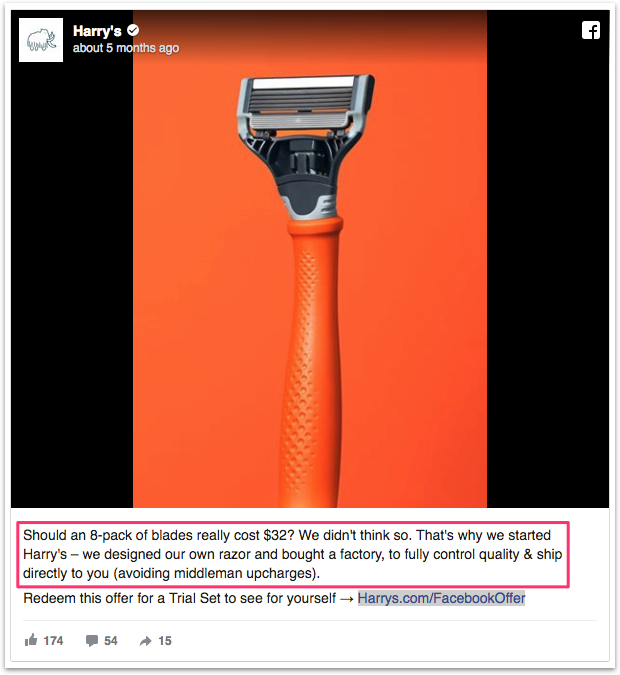
(Source: AdEspresso.)
When users click through, they’re directed to a landing page where they’re offered an immediate solution:
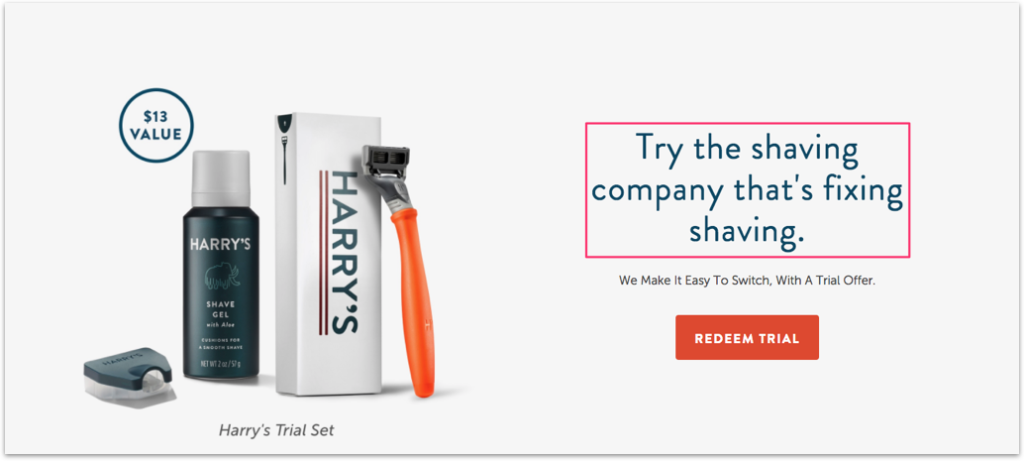
From there, Harry’s offers users a chance to begin a free trial. If they don’t convert, there’s an opportunity to retarget them with the below ad…
Ad #2. Objection Handling
This ad works well with a cart recovery email (see: Strategy #5).
Here’s how it works:
A user visits Harry’s site either through a search or by clicking an ad like the one above. They reach a product page or even a checkout page, but they leave their site before completing their order. They showed interest, but something prevented them from moving forward.
Later, they see an ad like the one below:
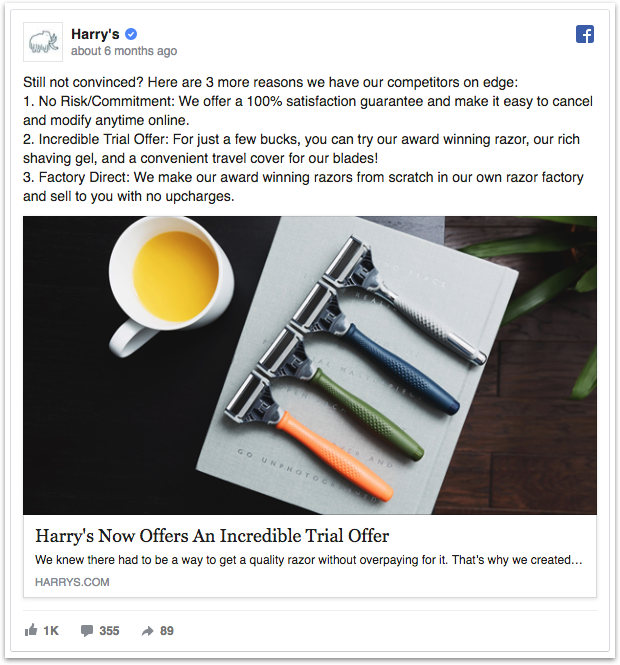
(Source: AdEspresso.)
A retargeting ad like the above works well for three key reasons:
- It’s personalized. It addresses the fact that the reader is already thinking about buying. The user visited the site before, but something prevented them from moving forward.
- It focuses on benefits over features. Harry’s customer-centric copy focuses on what the reader stands to gain from taking action.
- It offers an ironclad guarantee. No one wants to commit to something they might not want later. Harry’s knows this. So they offer a guarantee customers love (and competitors hate).
Beyond Facebook, this ad was consistent as a display ad as well, showing up on several websites users browsed later:

If users don’t return to their site, there’s one more opportunity to convert them…
Ad #3. Damage Mitigation
In 2017, Gillette, Harry’s biggest competitor, ran an advertisement that falsely proclaimed, “Most guys leave Harry’s after trying it.” So, what did Harry’s do? They reframed it as a marketing opportunity.
Check out the below ad they launched to address the elephant in the room:
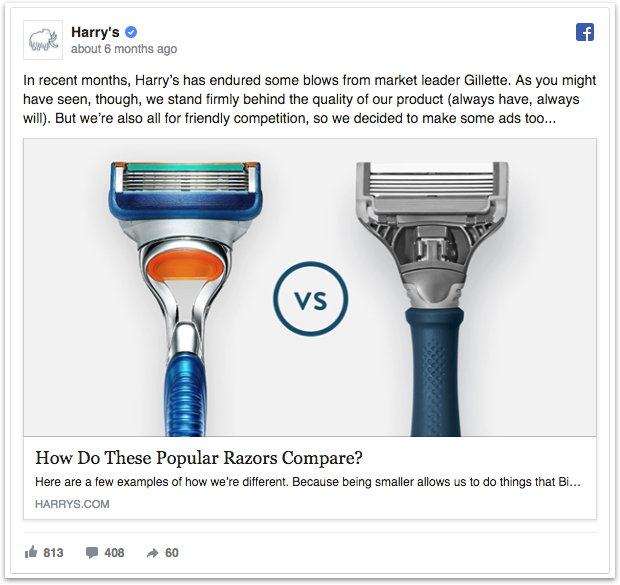
(Source: AdEspresso.)
When taking action, Harry’s directs users to an alternative page. On it, they address Gillette’s false advertising:

Then, they compare their razors to Gillette’s:
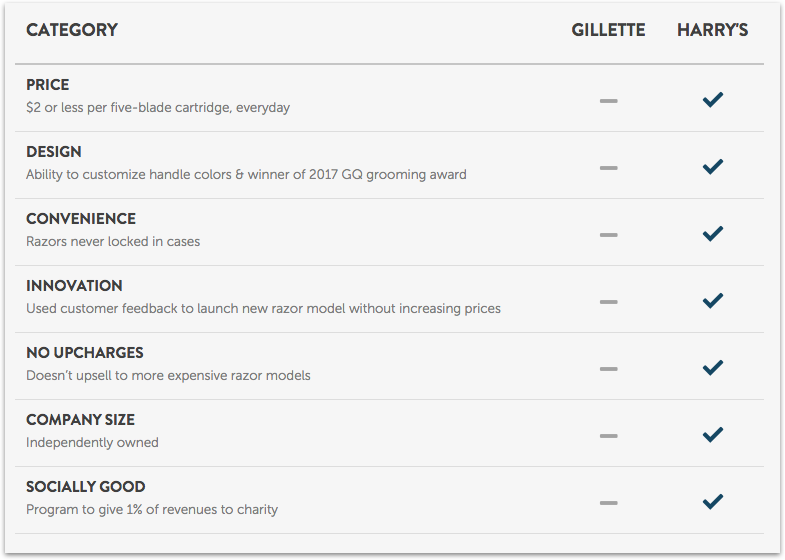
Finally, they give users a clear call to action:
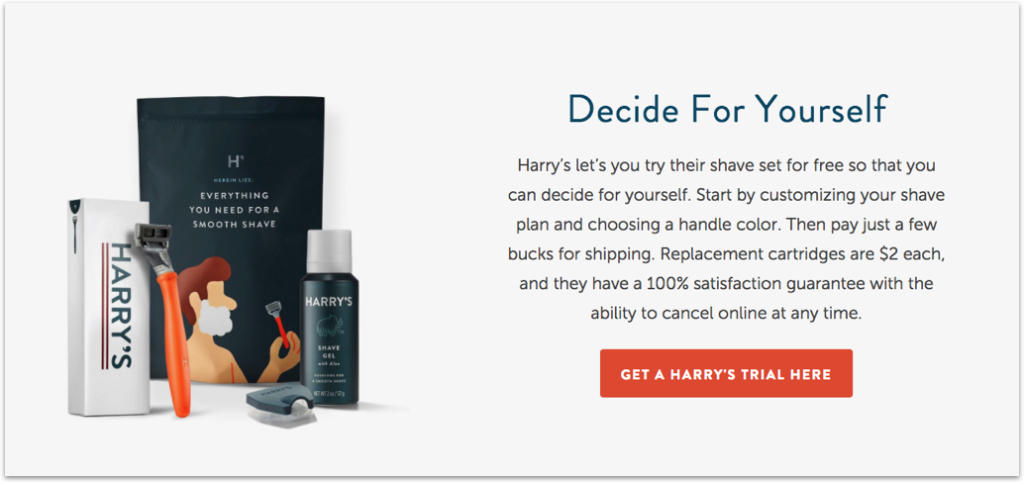
During a similar campaign, they use customer testimonials to differentiate themselves from their other competitor (Dollar Shave Club):
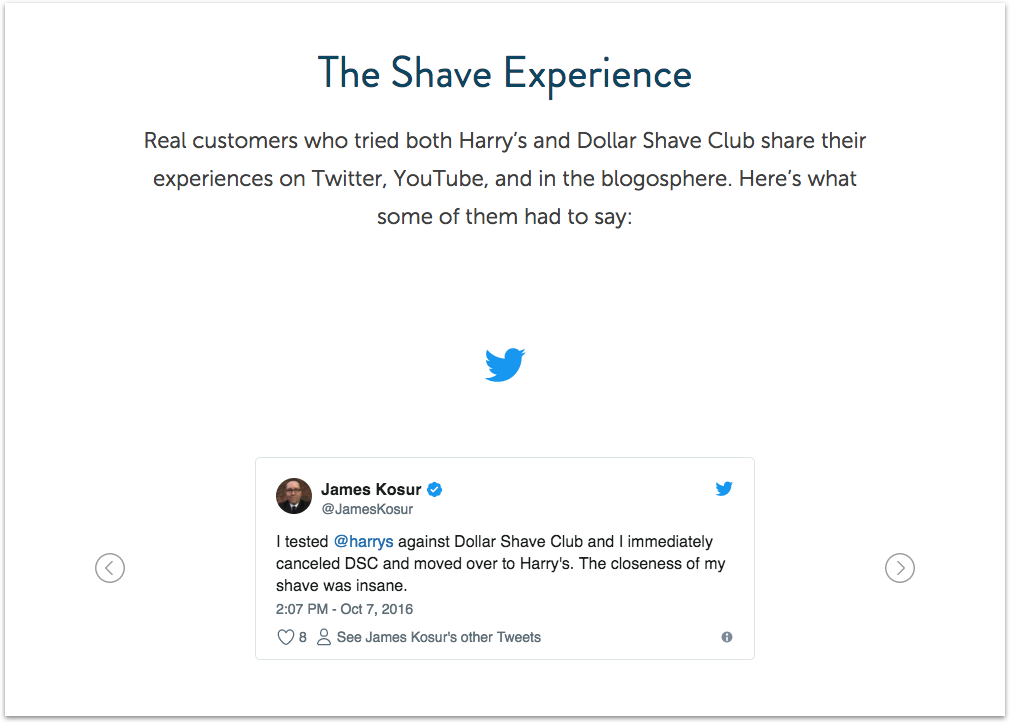
You won’t convert all users. That’s a given. But approaching them from different angles is an effective way to ensure you’re covering all your bases.
Action Items: Ask yourself, “What’s important to my customers?” Then, ask why again and again until you uncover what they really care about and what they’re really struggling with.
Finally, write ads that address the above, focusing on how your product is the vehicle that will move them from where they are to where they want to go. For more on angles, read this article by Charles Ngo.
5. Engage Subscribers and Increase Average Order Value (AOV) with “The CPS Method”
Harry’s relies on a handful of proven emails to fuel its sales engine. I identified three recurring types of emails, each with a specific goal. I call Harry’s approach to email marketing “The CPS Method”:
The three types of email focus on:
- Cart recovery (with a twist)
- Product praise
- Stealth promotion
Email #1: Cart Recovery (With a Twist)
Like many e-commerce companies, Harry’s knows the importance of sending recovery emails to close abandoning shoppers.
In fact, while researching for this article, I went through their checkout only to leave before buying (found out why in the bonus strategy).
A few days later, I received an abandoned cart email as expected:
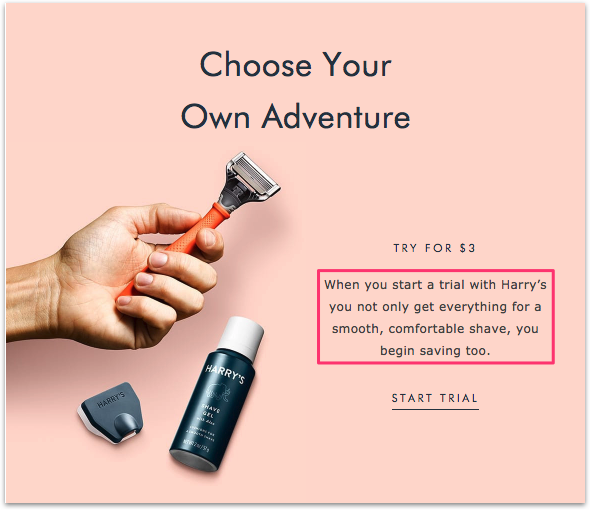
Nothing new here. That is until I scrolled down…
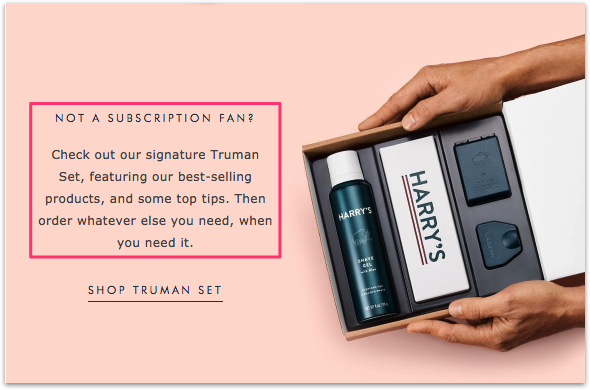
Harry’s offers a downsell to on-the-fence buyers. Why? Because they know they intrigued the user (after all, they got as far as checking out). But they also know something prevented them from moving forward.
Maybe it was the pricing. Or maybe, most likely, it was an objection to having to commit up-front. The downsell raises—and overcomes—their top objection and assures users there are no up-front commitments.
But there’s something else going on here…
The Truman Set is a $15 downsell. But when you go to checkout, there’s an opportunity for Harry’s to upsell you to a higher price point:
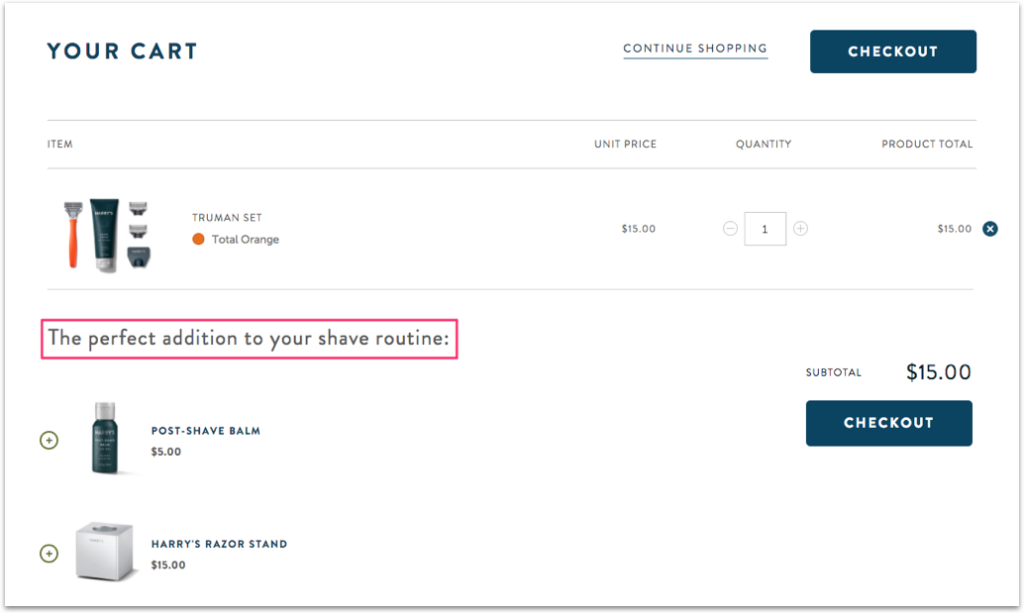
The downsell masquerades as an upsell.
Expanding on this, let’s look at some rough numbers:
- A Shaving Plan subscription is $3 on the front end, with the option to upsell to $15 or $21 during checking. This gives Harry’s a total of either $18 or $24 per customer after 30 days. (This is an oversimplification as there are many variables influencing customer lifetime value, such as delivery frequency, upgrading, downgrading, etc.)
- A Truman Set is a one-off payment of $15 on the front end with the option to upsell for $5 or $15 during checking. This gives Harry’s a total of either $20 or $30 per customer (with the potential to convert those customers into monthly subscription customers down the line).
Offering a downsell doesn’t only give Harry’s extra cash flow to offset ad spends and customer acquisition costs (CAC). It also allows them to get a foot in the door with potential subscription customers. Not everyone is ready to become a subscription customer, which, as you’ll see with Email #3, isn’t always the goal.
Action Item: Use abandoned cart emails to recover revenue, of course, but go one step further. Offer a downsell to anyone who might need further coaxing to buy from you. A good downsell acts as more than a tripwire; it’s also a hidden opportunity to upsell on the front or back end.
Email #2: Product Praise
Harry’s rarely sells their products in their emails. Instead, they have their customers sell for them.
Check out this recent email promoting their Face Wash:
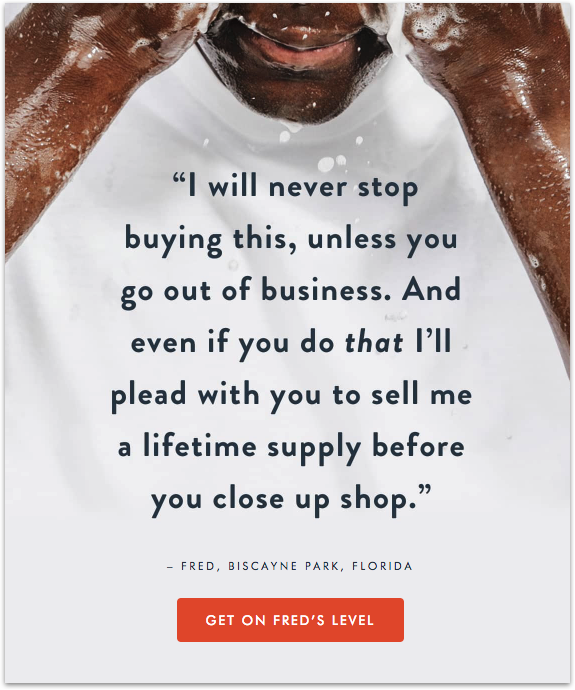
Note the wording here. This isn’t a generic testimonial (“I love Harry’s Face Wash”); it’s a humorous confession of an advocate’s undying devotion to their favorite brand.
Building on the above, Harry’s then uses compelling copy to create a “mental movie” for what it’s like using their product:
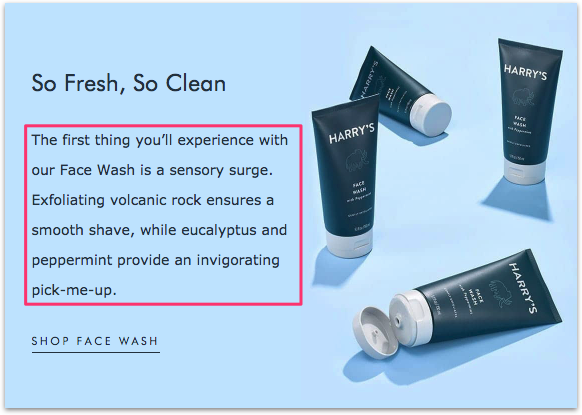
Using sensory adjectives and future-pacing, Harry’s walks the reader through the experience of using their product, from beginning to end, before following up with a clear call to action to buy.
If that isn’t good advertising, I don’t know what is.
Action Item: Using compelling copy to get people to buy is good. But using customer testimonials who sell your products and services for you is even better.
ProTip. Use humor if possible. The funnier and more memorable the customer’s quote, the more likely it is to “stick” in the reader’s mind—and convince them to buy from you.
Email #3: Stealth Promotion
Like many e-commerce stores, Harry’s often takes advantage of various holiday periods to engage readers—and drive more sales.
Take a look at the following email promoting Father’s Day:
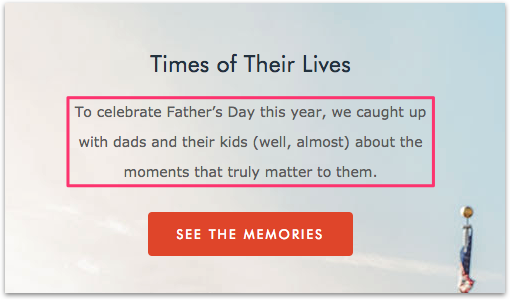
On the surface, it looks like a normal content promotion email, right? I thought so, too. That is until I clicked through to the content and began scrolling through their content…
Halfway down the page, Harry’s invited me to buy a box set, not for myself—for my dad.
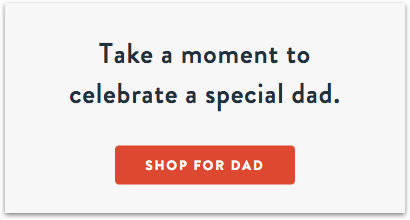
It’s subtle and completely under the radar—but it works like gangbusters.
Here’s why:
- It “anchors” a positive emotion to their product. Anchoring describes our tendency to rely too much on the first piece of information offered (the “anchor”) when making decisions. If you’re invited to think about your father, it’s likely to influence your decision if you’re asked to buy one of their products (especially if it’s for him).
- Its message is consistent throughout. Rather than direct users to their usual store page, Harry’s created a dedicated sales page with father-focused copy to move buyers to action (pictured below). They even changed the product itself to reflect the promotion, offering a new color. Now that’s dedication.
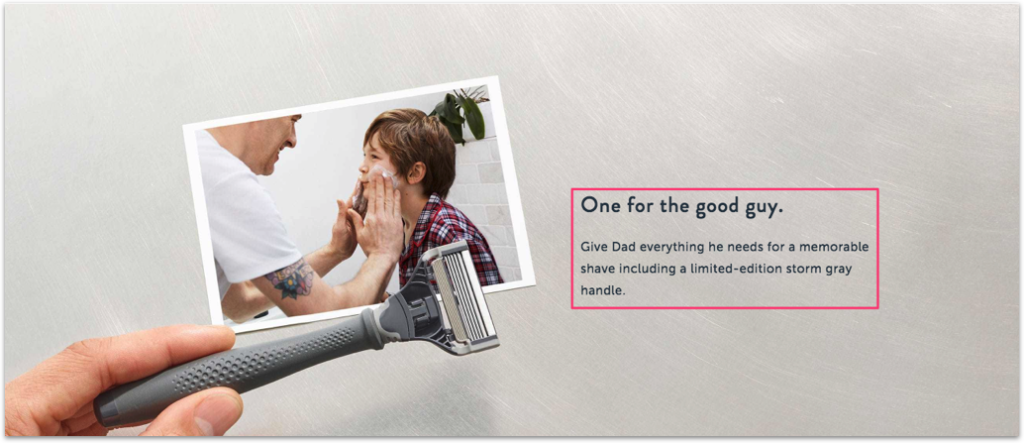
Action Item: Content isn’t only for generating traffic, converting visitors, and building links—it’s also a selling tool. Be warned, though: it’s hard to get right. Not everyone is ready to buy, remember? But if a prospect is ready, it’s a killer strategy for selling without selling.
ProTip. Schedule it to coincide with a national holiday or celebration (like above) and make your offer appeal to the buyer’s family rather than the buy themselves.
Which Will You Choose?
So, there you have it: the best of Harry’s marketing in under 4,000 words.
Let’s review each once more:
- Strategy #1: Create Brand Advocates with 3 Emotionally-Driven Story Archetypes
- Strategy #2: Win New Business with This Replicable Word-of-Mouth Referral Engine
- Strategy #3: Build White Hot, White Hat Backlinks with These 3 E-Commerce Link Building Tactics
- Strategy #4: Convert On-The-Fence Buyers with These 3 Proven Ad Angles
- Strategy #5: Engage Subscribers and Increase Average Order Value (AOV) with “The CPS Method”
My advice? Choose one, to begin with, invest time implementing it, and then if possible, make it better.

